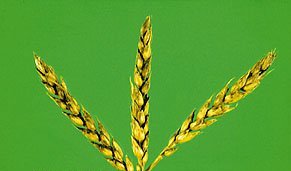Septoria Leaf And Glume Blotch In Wheat, Barley, And Oats
Septoria can infect all small grains. The symptoms may occur at any time during the growth of the plant and on any portion of the plant. There are two common forms of septoria. One causes only leaf blotch; the other causes both leaf and glume blotch.



Host Crops
Wheat, barley, oats
Biology
Septoria leaf and glume blotch overwinter on seed or crop residue as well as on the leaves of winter wheat. The dark-coloured fruiting structures release spores in the form of droplets which are spread by rain. These spores cause spring infections. Late summer infections are caused by wind-blown spores. Wet windy weather favours disease outbreaks, while dry weather stops disease development.
The spores also infect and colonize stems and the wheat head. When the head is colonized the florets become streaked with a purple-brown colour and 'dotted' with the minute black fruiting bodies. Within colonized florets, the grain fill is impaired and results in low test weight and shrivelled seeds.
The septoria leaf and glume blotch pathogen survives within infested straw, seed and on volunteer wheat and serves as the source of inoculum to start off the disease cycle in the new crop of wheat. The disease is favoured by splashing rain, high humidity, and temperatures between 20-28 degrees C (68-82 degrees F). The disease characteristically moves upward from infection initiated on the lower leaves within the crop canopy.
Symptoms Of Damage
Symptoms first appear as small spots on the lower leaves of seedlings. These spots grow into larger, lens-shaped lesions which are initially yellow and later turn reddish brown. They become grey or greyish-brown and speckled as tiny black fruiting bodies develop. Septoria causes more or less linear or rectangular lesions. There may be dark sporulating structures in the lesions. Note that with tan spot lesions are oval and tan.
On the chaff or glumes, brown marks start at the tips, develop downwards and later produce pepper-like black dots. Infection can also occur on the stems at the joints or nodes.
Scouting Techniques
Scout fields prior to flag leaf emergence.
Economic Thresholds
In some states in the USA, fungicide application is recommended if 25% of the leaves have one or more lesions. If the threshold is met in 3 of the 5 spots sampled in the field, spraying is recommended. If the threshold is met at 1 or 2 of the spots in the field, repeat scouting in about 4 days. You should consider rainfall forecasts as well as scouting information in your decision. Heavy rainfall favours the development of severe disease. Also, intervals between scouting can be longer if the weather is very dry.
Control Tips
- Current varieties have limited resistance. Incorporate wheat straw by tillage in the fall or early spring in fields not prone to erosion.
- Use a crop rotation that includes non-cereal crops for at least one year between successive wheat crops. Use lower seeding rates and use adequate rates of fertilizer.
- For fungicide applications, weather should be conducive to the spread of disease. Yield potential should be high enough so that the increased yield will cover the fungicide and application costs.

